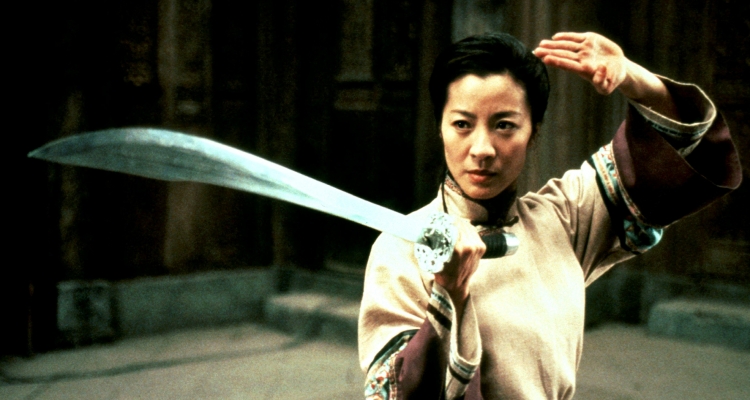After premiering his recent, polarizing “Billy Lynn’s Long Halftime Walk” at the New York Film Festival a few days ago, director Ang Lee was still in New York City, on hand for a special screening of “Crouching Tiger, Hidden Dragon” which is being released on 4K Ultra HD and will receive a limited edition release on Blu-ray. These are both epic formats suitable for the 120-minute film and its stunning landscapes of revenge, love and the art of Wudang —it remains the highest grossing foreign language film in American history. After the screening, Lee participated in a talk with screenwriter James Schamus and Michael Barker from Sony Pictures Classics, which released the film, and the three waxed nostalgic on the sometimes tedious production and when they knew that they had made something special.
Nominated for 10 Academy Awards including Best Picture, “Crouching Tiger, Hidden Dragon” won a total of four that year. Lee has consistently broken cinematic ground by utilizing new ways to tell stories through the use of digital technology. His 2012 film “Life of Pi” was his first foray into 3D, and his “Billy Lynn’s Long Halftime Walk” was filmed at 120 frames-per-second.
Born in Taiwan, Lee first came to the U.S. in the late 1970s. Having grown up during the Cold War, becoming a filmmaker and representing China as he experienced it was a longtime goal. “I did three English movies, and I thought they would let me do anything, even a martial arts film, even if I hadn’t done one. I wanted to go to five different regions [in China], but my producer said that I could only choose three,” he explained.
When asked about the emotionalism of the film and whether it’s hard to write a screenplay as such, where much of that aspect is kept under a tight wrap, Schamus simply said “Yes.”
”Traditionally, writing for Ang means underwriting. It means putting as little as possible on the page to give an impetus to Ang and the actors to push it somewhere else. When you have someone like Ang, the hard part is holding back and not doing what you are paid to do, which is to reassure studio executives that even if they hire their second or third choice, the film will still work. Rather, you stay underneath what you believe your director and his actors can achieve. That is the difficult part, holding back,” Schamus explained. He went on to talk about his dislike of editorializations, so much that whenever a battle was about to be engaged, the words “They Fight” appeared in the script. “The point was to craft the script in such a way that whenever you got to that moment, to set it up to understand that when the fight was over, it had advanced the story.”
Barker recalled the day the film opened on December 8, 2000 in New York City. Curious to see how the film was being received, Lee and Barker traveled to different theaters across town. “The first place we went to was Loews Astor Plaza and it wasn’t full, about 150 people, all different types and from all over the world. It was obvious they liked the film, so we went downtown to the Angelica, where it was a young crowd. Then we went up to Lincoln Plaza where it was a sea of white and blue hair, and they also liked the film, in a reserved way. Lee said that he wanted to go up to the Magic Johnson Theater to see what they think.”
The Magic Johnson Theater had never played a subtitled film before, and Lee and Barker were cautioned before entering the theatre that it wasn’t very full. “We sat at the back, and there must have been 30 people. We waited until after the first fight scene, and someone up front yelled, ‘Jesus Christ, did you see that?’ Then a kid ran out into the lobby and yelled at the top of his lungs ‘The good one is number ten!’ ” Barker said.
 Both Lee and Schamus weighed in on the making of the infamous bamboo fight scene in the Anji Bamboo Forest. “It was not exactly evident that we were going to get Chow Yun-Fat (as Wudang Warrior Li Mu Bai) sixty feet up on a wire hanging from a crane with no net, but luckily his manager, who happened to be his wife, had to go to the bathroom. The bathrooms were located about a twenty five minute walk from the set, and that happened to be the moment when Ang approached Chow Yun-Fat to see what he thought about going up on the bamboo. Needless to say, about an hour later she came back and it was not at all clear that Chow Yun-Fat’s manager was going to let him come back to the set the next day,” remembers Schamus.
Both Lee and Schamus weighed in on the making of the infamous bamboo fight scene in the Anji Bamboo Forest. “It was not exactly evident that we were going to get Chow Yun-Fat (as Wudang Warrior Li Mu Bai) sixty feet up on a wire hanging from a crane with no net, but luckily his manager, who happened to be his wife, had to go to the bathroom. The bathrooms were located about a twenty five minute walk from the set, and that happened to be the moment when Ang approached Chow Yun-Fat to see what he thought about going up on the bamboo. Needless to say, about an hour later she came back and it was not at all clear that Chow Yun-Fat’s manager was going to let him come back to the set the next day,” remembers Schamus.
Lee also weighed in, saying, “I think that had to do with it being Chinese. What I did to one of the biggest Asian movies stars, I couldn’t do now to a soundman.”

